Cas Holmes
Cas Holmes is one of UK's most renowned textiles artists who works as a paper-maker and stitcher. She uses embroidery and textiles to create visually rich narrative artworks and personal stories which are sourced from her everyday encounters and the world around her.
She is interested in links between land, place and the environment.
During Cas' upbringing her Romany grandmother encouraged an interest in reclaimed objects which would then be put to good use rather than being overlooked and her father taught her how 'to look', observe and ask questions during their walks together. A love of storytelling was also inherited from her Grandmother.
She graduated as a painter and fine artist but soon became drawn into the world of stitching. She works without defined boundaries using cutting, tearing, painting and stitching to produce a personal reaction to the historical, environmental and social heritage of a place.
I'm lucky enough to own a couple of her books Stitch stories and The found Object in Textile Art which look closely at how the everyday and familiar can be a starting point for developing ideas. She uses drawing to inform her ideas and uses journals and sketchbooks to research and record her experiences.
In Stitch Stories she describes her use of Stitch Sketching to record daily observations which may then be developed into textile pieces
A self confessed 'magpie' Cas is renowned for her use of found objects in her work. She encourages the reader to view the everyday object with an artist's eye. Found objects may range from the humble to the opulent and may be small, natural or man-made. These can be used to convey meaning or add decoration.
She states that with making comes meaning and that our exploration of everyday events and objects can bring meaning as we reflect upon the world we live in.
Cas trained as a painter and fine artist at Maidstone College of Art and continued her studies during fellowships to Japan.
She teaches at Middlesex University, exhibits widely and runs courses hibits widely and runs courses at West Dean college, Sussex.at West Dean college, Sussex.
In relation to Module 4:
Cas is renowned for her paper making which as demonstrated above she uses to construct beautiful book structures in which to record her observations and Stitch Stories.
Information from: www.casholmestextiles.co.uk
Stitch Stories. Cas Holmes published by Bashford 2015
The Found Object in Textile Art. Cas Holmes published by Batsford 2010
Lois Walpole
Lois Walpole was born in London of Anglo Scottish heritage. She graduated from Saint Martins School of Art, London with a B.A.(Hons.) in Sculpture in 1975 and obtained City and Guilds qualifications in Basket Making from the London College of Furniture in 1982. In 2003 she completed a Doctorate in the Design department at the Royal College of Art in London.
Since 1982 she has worked full time as an artist/ basket maker taking part in and curating national and international exhibitions, working to commission, designing for production, teaching and writing.
From 1972 to 2005 she lived in London. Now she divides her time between the Shetland Islands and the Charente, in south west France, where her studio is based.
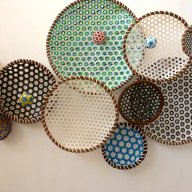
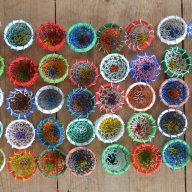
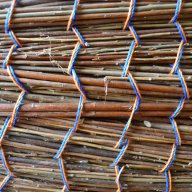
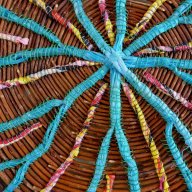
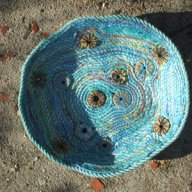
Lois is one of Britain's most influential basket makers known for her creation of innovative designs from hand painted recycled cardboard and recycled packaging. She enjoys making use of everyday objects such as ring pulls, mine corks and wire as well as using the repeat of a graphic design to make her eye catching objects.
She uses traditional methods to produce unconventional items in that they are not created with a purpose in mind.
In relation to module 4:
I can see the use of grids through weaving in Lois' work which relates to work in this module as well as the more delicate pieces where I can see patterns discovered in my Drawn Threadwork. In her woven items I can see the patterning I achieved when experimenting with different ways of lettering.
Information taken from http://loiswalpole.com
I'd like to include Alice Fox as my third artist for this exercise.
Her fascination with the natural world and all things organic are recorded and embodied into her textile pieces. Although I have worked to brief for this module and included aspects relating to the media, grids, letter pattering and drawn thread work I feel there is a further element involving the natural world where I have represented my observations of the Fall in New York and the forest floor
I'm particularly drawn to her work with leaves and the handmade book both shown in photographs below. Whilst her work embodies rather than directly represents the natural world and mine offers a more stylised look I feel a connection with her work.
Alice graduated in Contemporary Surface Design and Textiles at the School of Arts and Media, Bradford and has been a finalist in the Craft and Design Selected Maker Award 2015.
Alice is a member of The Textile study Group and The Society of Master Craftsmen
Alice fox Artist statement - taken from The Textile study Group website:
My practice brings together recording, collecting and interaction with the landscape. I have always been fascinated by the detail of organic things and the work that I produce celebrates and carries an essence of what I experience in the natural world. I aim to draw the viewer in, invite them to look closer and notice things they might otherwise have overlooked.
Much of my work is based on experiences of coastal landscapes. The beach and its hinterland can be the richest source of experience and discovery. Through the cycle of tides and weather it collects daily treasures and detritus by turn, providing a visual and tactile adventure. My starting point is usually walking, recording my experience through words, sketches, photographs and collected items. I notice lines, patterns, shapes and textures. I try to capture small changes: the way material is moved about by the elements. Wherever I am I take a beach-comber's approach, found objects providing a tangible link to the places I've walked.
I work with natural fibres (paper, cloth and thread) and use natural dye techniques, print, stitch and weave in different combinations. My work develops through layering up marks and textures, building up subtle surfaces and structures that combine the textural qualities of textile and printmaking processes. Found items, their identity often a mystery because of the action of the elements, form the focus of my response to a landscape.
I am concerned with embodiment of the landscape rather than direct representation. Each piece can be seen as a small record of a walk: a journey or moment from a journey. The works I produce are contemplative and quiet, but look closely and you'll discover there is complex activity; patterns can appear both random and organized. Look again and there is something new to discover.





































